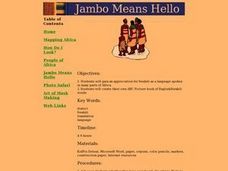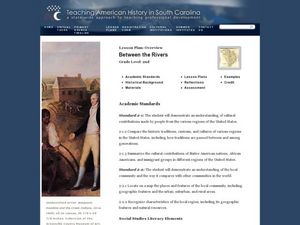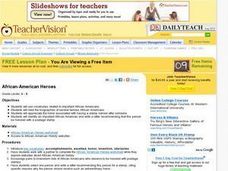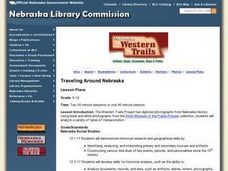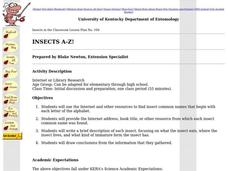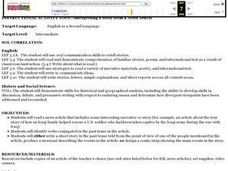Curated OER
Chinese Puzzle Story
Learners study the Chinese form of tangrams. They read the story, "Grandfather Tang's Story," by Ann Tompert and discuss how tangrams are used to tell the story. Using paper and scissors, they create animal tangrams and write stories...
Curated OER
Discovering Swahili
Students investigate the African language of Swahili by translating vocabulary words. In this foreign language lesson, students write 26 English words that define Africa and utilize the Internet to translate them into Swahili....
Curated OER
Air Pollution
Students research and find information on air pollution. In this air pollution lesson plan, students answer short answer questions about air pollution.
Curated OER
Solving Problems
For this solving problems worksheet, learners answer twelve multiple choice questions about problem solving in science and the steps of the scientific method. These include identifying the problem, forming a hypothesis and setting up the...
Curated OER
Between the Rivers
Second graders compare and contrast historical American cultures. In this American history lesson, 2nd graders participate in reading, writing, oral, and hands on activities. Students discuss the similarities and differences...
Curated OER
Newspapers
Students create a class newspaper about the Olympics. In this newspaper lesson, students discuss the basic characteristics of each component of the newspaper. Students work in small groups to complete stations on cartoons,...
Curated OER
Applied Science - Science and Math Lab (read without sight)
Learners consider the senses. For this sight and touch lesson, students discover what it is like to function like a person who is blind. They work in groups and individually on various activities to experience this condition. This lesson...
Curated OER
Outline and Shine
Seventh graders read and discuss a short story. They complete an outline of the story. They pair and share to evaluate each other's outlines.
Curated OER
Language Arts: Character Comparison
Fourth graders, using Kidspiration, compare and contrast the two main characters from Tales of a Fourth Grade Nothing. They use a teacher-created template to describe their characters. Students then create their own character analysis.
Curated OER
Real or Painted Art -- Tromp l'oeil Art Awareness an Activities
Students are introduced to Trompe l'oeil art by a docent. Using that information, they compare and contast it with other forms of art they are familiar with and discuss their opinions with the class. They write a poem about their...
Curated OER
Issues Close to Home
Students brainstorm as a class about their role in the local government. In groups, they use various types of media to discover how it is affecting their lives. They choose one issue and state their position to share with the class. To...
Curated OER
African-American Heroes
Students explore websites about famous African-Americans. They work in pairs to decide on an African American who should be honored with a stamp. They write a letter recommending this person for a stamp including appropriate reason why...
Curated OER
Two Faces of Paul Gauguin
Middle schoolers examine Paul Gauguin's self-portraits and letters to explore the individual who created them. They consider how first-person art forms aid the process of self-discovery and produce a symbolic self-portrait
Curated OER
Lesson 1: Design a Transportation Stamp
Students, in groups, research a certain form of transportation that has affected Maine's economic and cultural development. They write a persuasive letter that uses the research to support an argument.
Curated OER
Traveling Around Nebraska
Students analyze a current or historical photograph from their textbook and as a class complete a worksheet of the analysis. Using the Photographic Analysis Form, they locate and analyze two transportation photographs and use the...
Curated OER
Insects A-Z!
Pupils use the Internet and other resources to find insect common names that begin with each letter of the alphabet. They write a brief description of each insect, focusing on what the insect eats and where the insect lives.
Curated OER
Social Studies: Ramadan Observance
Students discuss Ramadan and the practice of fasting. Working in groups, they visit Websites and complete worksheets about the Muslim holiday. Students write letters role-playing as someone unfamiliar with a celebration and then write...
Curated OER
Looking At French Decorative Arts: Makers of Nothing, Sellers of Everything
Students compare/contrast the role of merchant to that of his modern-day business counterpart. They role-play that they are 18th-century merchants, and write persuasive letters to sell French beds for clients.
Curated OER
Monster Dictionary
Third graders explore several retrieval strategies to find information in a variety of sources. They organize the information they find and create a Monster Dictionary that includes imaginary monsters and their definitions.
Curated OER
Air Conditioning
Learners explore the roles that the United States government agencies play in weather forecasting, climate control, and other climate-related environmental issues. They then write letters to President Bush recommending how a new National...
Curated OER
Cloudy With A Chance of Meatballs
Third graders use a variety of information resources to identify local environmental issues and examine the ways that people have tried to solve these problems. They read "Cloudy With A Chance of Meatballs" and create a list of three...
Curated OER
Interpreting a Story from a News Article
Students read and retell a story form out of the newspaper. They write to communicate ideas, stories, letters, simple explanations, and short reports. They edit and perfect their projects for homework, and they share their work with the...
Curated OER
Africa: What's in a Name?
Students research the Yoruba Tribe and names. In this names lesson, students read the story 'Don't Call Me Names' and discuss how people get their names. Students discuss the importance of names and learn about the Yoruba Tribe. Students...
Curated OER
Taking a Page From Franklin
Students analyze sentences from Benjamin Franklin. They use their notes to state the same ideas in essay form. They compare the new work to Franklin's orginal work.

